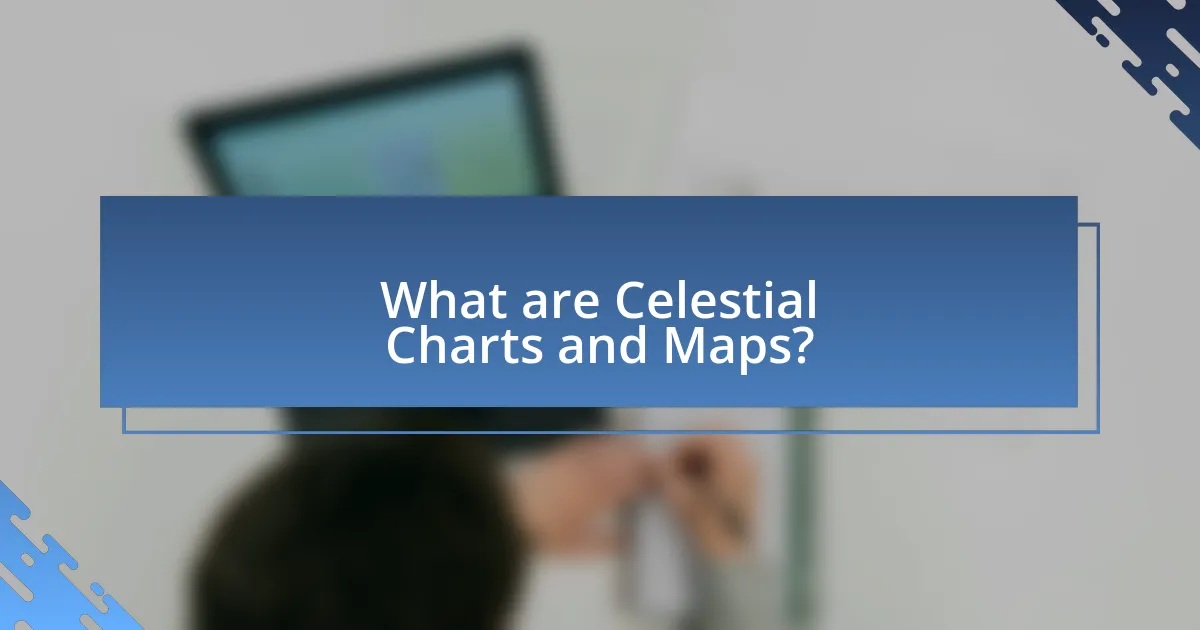Celestial charts and maps are essential tools for stargazers and astronomers, providing graphical representations of the night sky that depict the positions of stars, planets, and other celestial objects. This article outlines the differences between celestial charts and maps, highlighting their specific features and importance for navigation and observation. It also covers how to read these tools, identify constellations, and utilize various resources and techniques to enhance the stargazing experience. Additionally, practical tips for effective stargazing and common mistakes to avoid when using celestial charts are discussed, ensuring readers can maximize their observational skills and enjoyment of the night sky.

What are Celestial Charts and Maps?
Celestial charts and maps are graphical representations of the night sky, depicting the positions of stars, planets, and other celestial objects. These tools are essential for astronomers and stargazers, as they provide a way to identify and locate celestial bodies based on their coordinates and visibility at specific times. For example, celestial maps often include constellations, which are patterns formed by groups of stars, and can indicate the location of planets within those constellations. The accuracy of celestial charts is supported by astronomical data collected over centuries, making them reliable resources for navigation and observation in astronomy.
How do celestial charts and maps differ from each other?
Celestial charts and maps differ primarily in their purpose and representation of celestial objects. Celestial charts are designed to provide a detailed view of the night sky, showing the positions of stars, constellations, and other celestial phenomena at a specific time and location. In contrast, celestial maps serve as broader navigational tools, often depicting the entire celestial sphere and helping users locate celestial objects based on coordinates rather than specific time-based positions. This distinction is supported by the fact that celestial charts are often used for observational astronomy, while celestial maps are utilized for navigation and orientation in the sky.
What are the key features of celestial charts?
Celestial charts are graphical representations of the night sky, showcasing the positions of stars, planets, and other celestial objects. Key features of celestial charts include a coordinate system, typically using right ascension and declination, which allows users to locate objects in the sky accurately. Additionally, celestial charts often depict constellations, which are patterns formed by groups of stars, aiding in navigation and identification. The charts may also include labels for prominent stars and celestial bodies, as well as information about celestial events such as meteor showers or eclipses. Furthermore, some celestial charts are designed for specific times and locations, providing a tailored view of the sky based on the observer’s geographic position and the date.
What are the key features of celestial maps?
Celestial maps are graphical representations of the night sky that display key features such as constellations, stars, planets, and celestial coordinates. These maps typically include a grid system based on celestial coordinates, which helps users locate objects in the sky. Additionally, celestial maps often depict the ecliptic, the Milky Way, and significant celestial events like meteor showers or eclipses. The use of symbols and color coding enhances the clarity of information, allowing for easier interpretation by stargazers. Historical celestial maps, such as those created by Ptolemy or Tycho Brahe, serve as foundational examples of how these features have evolved over time, demonstrating their importance in navigation and astronomy.
Why are celestial charts and maps important for stargazing?
Celestial charts and maps are important for stargazing because they provide a visual representation of the night sky, helping observers identify stars, constellations, and celestial events. These tools enable stargazers to navigate the vastness of space by offering precise locations of celestial objects, which enhances the overall stargazing experience. For instance, celestial maps often include coordinates and labels that correspond to specific stars and constellations, allowing users to locate them easily. Additionally, historical data shows that astronomers have relied on such charts for centuries to track celestial movements, making them essential for both amateur and professional stargazers.
How do they enhance the stargazing experience?
Celestial charts and maps enhance the stargazing experience by providing detailed visual representations of the night sky, allowing observers to identify constellations, stars, and celestial events more easily. These tools offer precise coordinates and information about celestial objects, which helps stargazers locate and understand what they are viewing. For instance, charts often include labels for prominent stars and constellations, making it simpler for individuals to connect what they see with their knowledge of astronomy. Additionally, many celestial maps incorporate data on the visibility of planets and meteor showers, further enriching the stargazing experience by informing observers of optimal viewing times and locations.
What role do they play in astronomical education?
Celestial charts and maps play a crucial role in astronomical education by providing visual representations of the night sky, which facilitate the understanding of celestial objects and their positions. These tools help learners identify constellations, planets, and other astronomical phenomena, enhancing their observational skills. Studies have shown that using visual aids like celestial maps significantly improves retention and comprehension of astronomical concepts, making them essential for effective teaching in the field.

How to Read Celestial Charts and Maps?
To read celestial charts and maps, first identify the key components such as the celestial sphere, coordinate systems, and symbols representing stars and constellations. Celestial charts typically use a grid system similar to latitude and longitude on Earth, with right ascension and declination as the primary coordinates. Understanding these coordinates allows you to locate celestial objects in the night sky. For example, right ascension measures the angle along the celestial equator, while declination measures the angle above or below it. Familiarizing yourself with the symbols and legends on the chart will help you interpret the information accurately. Additionally, many charts include a date and time reference, which is crucial for aligning the chart with the current sky view.
What are the basic symbols and notations used in celestial charts?
The basic symbols and notations used in celestial charts include stars, planets, constellations, and celestial coordinates. Stars are typically represented by dots, with their size indicating brightness, while planets are often depicted as circles or specific symbols. Constellations are illustrated by connecting lines between stars to form recognizable shapes. Celestial coordinates, such as right ascension and declination, are indicated using a grid system that helps locate objects in the sky. These symbols and notations are standardized in astronomical charts, ensuring consistency and accuracy for stargazers and astronomers alike.
How can one identify constellations on a celestial chart?
To identify constellations on a celestial chart, one should first locate the prominent stars that form the constellation’s shape. Celestial charts depict the night sky from a specific location and time, showing the positions of stars and constellations. By matching the patterns of stars on the chart with those visible in the sky, individuals can recognize constellations. For example, the Big Dipper, part of Ursa Major, is easily identifiable by its distinct shape, which can be found on most celestial charts. This method relies on the consistent mapping of stars, as constellations are defined by their relative positions in the sky, making celestial charts reliable tools for stargazing.
What do different colors and lines represent on celestial maps?
Different colors and lines on celestial maps represent various astronomical features and coordinate systems. For instance, blue lines typically indicate celestial equators and ecliptic planes, while red lines often denote the celestial meridians. Additionally, colors can signify different types of celestial objects; for example, stars may be represented in yellow or white, while nebulae might appear in shades of pink or green. These visual distinctions help users identify and navigate the night sky more effectively, as they provide essential information about the positions and types of celestial bodies.
How can one determine the position of celestial objects?
One can determine the position of celestial objects by using astronomical coordinates, specifically right ascension and declination, which are analogous to longitude and latitude on Earth. These coordinates allow astronomers to pinpoint the location of stars, planets, and other celestial bodies in the sky. For instance, the right ascension of an object indicates its position along the celestial equator, while declination specifies its angle above or below this plane. This system is standardized and widely used in celestial navigation and stargazing, enabling accurate tracking of objects across different times and locations.
What techniques can be used to locate stars and planets?
Techniques used to locate stars and planets include the use of celestial charts, star maps, and telescopes. Celestial charts provide a visual representation of the night sky, allowing observers to identify constellations and celestial objects based on their positions relative to Earth. Star maps, often tailored for specific locations and times, help stargazers pinpoint the location of stars and planets by indicating their coordinates. Telescopes enhance visibility, enabling detailed observation of distant celestial bodies. These methods are supported by astronomical principles, such as the understanding of celestial coordinates and the movement of celestial objects, which are fundamental to navigation in the night sky.
How does time and location affect celestial observations?
Time and location significantly influence celestial observations by determining which celestial bodies are visible and their positions in the sky. The Earth’s rotation causes the apparent movement of stars and planets, meaning that observations change throughout the night and across different seasons. For instance, certain constellations are only visible during specific months due to the Earth’s orbit around the Sun. Additionally, geographic location affects visibility; for example, observers at higher latitudes may see different stars compared to those at the equator. This is supported by the fact that the North Star, Polaris, is only visible from the Northern Hemisphere, illustrating how location directly impacts what can be observed in the night sky.

What Tools and Resources are Available for Stargazing?
The primary tools and resources available for stargazing include telescopes, binoculars, stargazing apps, star charts, and online resources. Telescopes allow for detailed observation of celestial objects, while binoculars provide a portable option for viewing the night sky. Stargazing apps, such as SkySafari and Star Walk, utilize augmented reality to help users identify stars and constellations in real-time. Star charts serve as physical guides to the night sky, often depicting constellations and celestial events. Online resources, including websites like NASA and the American Astronomical Society, offer educational materials and updates on astronomical events, enhancing the stargazing experience.
What types of telescopes and binoculars are best for beginners?
Refractor telescopes and 7×50 binoculars are the best options for beginners. Refractor telescopes provide clear images and are easy to use, making them ideal for newcomers to astronomy. The 7×50 binoculars offer a good balance of magnification and field of view, allowing beginners to easily locate celestial objects. Both types are user-friendly and require minimal setup, which is essential for those just starting in stargazing.
How do different magnifications affect stargazing?
Different magnifications significantly affect stargazing by altering the level of detail and the field of view observed. Higher magnifications provide a closer view of celestial objects, allowing for detailed observation of features such as craters on the Moon or the rings of Saturn. However, increased magnification also narrows the field of view, making it more challenging to locate objects and increasing sensitivity to atmospheric disturbances, which can blur images. Conversely, lower magnifications offer a wider field of view, making it easier to locate and track objects, but may sacrifice detail. Research indicates that optimal magnification for stargazing often falls between 20x to 50x for telescopes, balancing detail and field of view effectively.
What accessories enhance the stargazing experience?
Accessories that enhance the stargazing experience include telescopes, binoculars, star charts, and red LED flashlights. Telescopes provide detailed views of celestial objects, allowing for deeper exploration of planets and galaxies. Binoculars offer a portable option for observing the night sky, making it easier to spot constellations and star clusters. Star charts serve as guides to help identify celestial bodies and navigate the night sky effectively. Red LED flashlights preserve night vision, enabling stargazers to read charts and adjust equipment without losing sight of the stars.
What online resources and apps can assist in interpreting celestial charts?
Online resources and apps that assist in interpreting celestial charts include Stellarium, SkySafari, and Star Walk 2. Stellarium is a free planetarium software that provides realistic sky simulations, allowing users to visualize celestial objects and their positions. SkySafari is a comprehensive app that offers detailed star maps and information about celestial bodies, catering to both beginners and advanced astronomers. Star Walk 2 is an interactive stargazing app that enables users to identify stars, constellations, and planets in real-time using augmented reality. These tools enhance the understanding of celestial charts by providing interactive and informative experiences for users.
How can mobile apps improve stargazing accuracy?
Mobile apps can improve stargazing accuracy by utilizing augmented reality (AR) technology to overlay celestial objects onto the night sky. This feature allows users to point their devices at the sky and receive real-time information about stars, planets, and constellations, enhancing their observational experience. For instance, apps like SkySafari and Star Walk 2 provide precise location data and time adjustments, ensuring that users can accurately identify celestial bodies based on their geographical position and the current date and time. Additionally, these apps often include databases of astronomical events, such as meteor showers and planetary alignments, which further aids users in planning their stargazing sessions for optimal accuracy.
What websites provide updated celestial events and guides?
Websites that provide updated celestial events and guides include NASA’s official site, which offers comprehensive information on astronomical events, and Time and Date, known for its detailed celestial calendars. Additionally, Sky & Telescope provides regular updates on skywatching events and guides for stargazers. These websites are reliable sources for accurate and timely information on celestial happenings, ensuring enthusiasts stay informed about upcoming astronomical events.
What are some practical tips for effective stargazing?
To effectively stargaze, choose a dark location away from city lights, as light pollution significantly hinders visibility of celestial objects. Use a star chart or stargazing app to identify constellations and planets, enhancing your ability to locate specific stars. Additionally, allow your eyes to adjust to the darkness for about 20 minutes, which improves night vision and reveals fainter stars. A telescope or binoculars can also enhance the experience by providing clearer views of celestial bodies. These practices are supported by astronomy guidelines that emphasize the importance of dark skies and proper equipment for optimal stargazing.
How can one prepare for a successful stargazing session?
To prepare for a successful stargazing session, one should choose a location with minimal light pollution, ideally away from city lights. This enhances visibility of celestial objects, as light pollution can significantly diminish the clarity of the night sky. Additionally, checking the weather forecast for clear skies is crucial, as overcast conditions can obstruct views of stars and planets. Using a stargazing app or celestial chart can help identify constellations and planets visible that night, providing a structured approach to observing the sky. Furthermore, bringing necessary equipment such as binoculars or a telescope can enhance the experience by allowing for closer views of celestial bodies. Lastly, allowing the eyes to adjust to the darkness for about 20 minutes will improve night vision, making it easier to see fainter stars.
What common mistakes should be avoided when using celestial charts?
Common mistakes to avoid when using celestial charts include misreading the scale and orientation of the chart, which can lead to incorrect identification of celestial objects. Users often overlook the importance of understanding the coordinate system, such as equatorial coordinates, which is crucial for accurate navigation in the night sky. Additionally, failing to account for local light pollution and atmospheric conditions can result in a misleading perception of visibility. Lastly, not cross-referencing with reliable sources or updated charts can lead to outdated information, affecting the overall stargazing experience.


